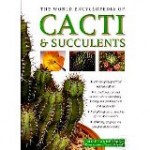 With the increasing concern for water availability the interest in xeriscaping has risen and what better plants to use than cacti and succulents? Their variation in shape, size, and colors makes them attractive plants in any garden but their low water needs gives them a special appeal or areas with low rainfall or restricted water use. Miles Anderson’s Encyclopedia of Cacti and Succulents provides pictures and information on over 400 varieties of cacti and succulents as well as design ideas and comprehensive directions for their maintenance and cultivation.
With the increasing concern for water availability the interest in xeriscaping has risen and what better plants to use than cacti and succulents? Their variation in shape, size, and colors makes them attractive plants in any garden but their low water needs gives them a special appeal or areas with low rainfall or restricted water use. Miles Anderson’s Encyclopedia of Cacti and Succulents provides pictures and information on over 400 varieties of cacti and succulents as well as design ideas and comprehensive directions for their maintenance and cultivation.
The largest part of the work is devoted to a plant directory divided into two major sections, cacti and succulents. Each group is further subdivided by genera, which are alphabetically listed. Each genus is described with one or more species given further attention. Information and a photograph is provided for each plant including natural habitat, temperature, soil, and light requirements, flowering characteristics, propagation, growth rate, and suggestions for the best place to grow the plant. In addition, historical background, relationship to other common garden plants, suitability for bonsai and other tidbits are included where pertinent. So for example, we learn that the flowers of Fraile cactus set seed without ever opening, species of Monsonia lives in an area that receives no measurable rain for several years, and the common geranium has several succulent relatives.
If you are new to growing cacti and succulents you will be especially interested in the chapters on cultivation techniques including choosing the proper container, planting techniques, routine, maintenance, pests and disease control, and propagation including grafting. A chapter on design ideas includes sections on indoor and outdoor cultivation with special attention given to both container gardening and using cacti and other succulents in garden beds. A glossary, lists of plants for special situations, and index concludes the work.
The book has features to recommend it to both the beginner and more advanced enthusiast. It lacks, however, a key or some other way to identify a specific plant. The pictures provide a very valuable aid in identification but the readers have to go through the pictures one by one starting at the beginning to find the one that interests them unless they know the botanical name of the plant. This makes the book very valuable for leaning about plants that you have the botanical name for but not so well for plants you want to identify first.
To buy The World Encyclopedia Cacti & Succulents from Amazon.com click here.